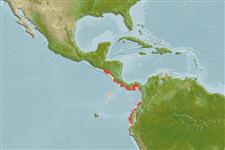Environment: milieu / climate zone / depth range / distribution range
Écologie
marin; saumâtre; profondeur 0 - 50 m (Ref. 189). Tropical; 14°N - 4°S, 89°W - 76°W (Ref. 189)
Eastern Pacific: El Salvador to Ecuador, perhaps south to northern Peru.
Taille / Poids / Âge
Maturity: Lm ? range ? - ? cm
Max length : 7.7 cm SL mâle / non sexé; (Ref. 189)
Épines dorsales (Total): 0; Épines anales 0; Rayons mous anaux: 16 - 22. Snout moderate, about 3/4 eye diameter; maxilla quite long, tip pointed, reaching almost to edge of gill cover; lower gill rakers increasing in larger fishes; pseudobranch long, extending onto inner face of operculum; gill cover canals of panamensis-type. Anal fin short, its origin under posterior third of dorsal fin base. Broad silver stripe along flank, lost with age.
Occurs in coastal waters. In the Gulf of Nicoya, Costa Rica, it is confined to the inner parts, thus apparently tolerating lowered salinities
Life cycle and mating behavior
Maturité | Reproduction | Frai | Œufs | Fécondité | Larves
Spawn in school (Ref. 205).
Whitehead, P.J.P., G.J. Nelson and T. Wongratana, 1988. FAO Species Catalogue. Vol. 7. Clupeoid fishes of the world (Suborder Clupeoidei). An annotated and illustrated catalogue of the herrings, sardines, pilchards, sprats, shads, anchovies and wolf-herrings. FAO Fish. Synop. 125(7/2):305-579. Rome: FAO. (Ref. 189)
Statut dans la liste rouge de l'IUCN (Ref. 130435)
Menace pour l'homme
Harmless
Utilisations par l'homme
Pêcheries: d'intérêt potentiel
Plus d'informations
RéférencesAquacultureProfil d'aquacultureSouchesGénétiqueElectrophoresesHéritabilitéPathologiesTraitementNutrientsMass conversion
CollaborateursImagesStamps, Coins Misc.SonsCiguateraVitesseType de nageSurface branchialeOtolithesCerveauxVision
Outils
Articles particuliers
Télécharger en XML
Sources Internet
Estimates based on models
Preferred temperature (Ref.
123201): 22.3 - 28.5, mean 27.1 °C (based on 32 cells).
Phylogenetic diversity index (Ref.
82804): PD
50 = 0.5000 [Uniqueness, from 0.5 = low to 2.0 = high].
Bayesian length-weight: a=0.00513 (0.00232 - 0.01135), b=3.14 (2.96 - 3.32), in cm total length, based on LWR estimates for this Genus-body shape (Ref.
93245).
Niveau trophique (Ref.
69278): 3.3 ±0.4 se; based on size and trophs of closest relatives
Résilience (Ref.
120179): Haut, temps minimum de doublement de population inférieur à 15 mois (Preliminary K or Fecundity.).
Fishing Vulnerability (Ref.
59153): Low vulnerability (10 of 100).
